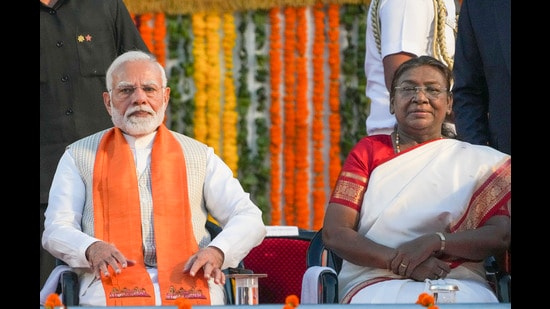Our Terms & Conditions | Our Privacy Policy
Lanka, Nepal look to India’s GatiShakti infra platform | Latest News India
Nepal and Sri Lanka are in discussions with New Delhi to adopt India’s integrated project planning tool, which has cleared infrastructure projects worth over ₹15 lakh crore since its launch three years ago, according to a top government official.
Prime Minister Narendra Modi (PTI)
Industry secretary Amardeep Singh Bhatia said the proposals are under consideration, and that while Nepal is interested in project-specific implementation, Sri Lanka is interested in implementing PM GatiShakti across its entire system.
Prime Minister Narendra Modi launched GatiShakti — National Master Plan for multi-modal connectivity on October 13, 2021, in New Delhi.
Department for Promotion of Industry and Internal Trade secretary Bhatia said India is willing to assist its neighbours in improving their infrastructure project planning, which would be complementary.
Following implementation for large-scale projects at the centre and state levels, the government plans to utilise the tool for district-level project planning. “In the last three years, we have used PM GatiShakti to plan 208 projects worth 15.39 lakh crore rupees,” Bhatia said. The system is now being used by 36 states and Union territories, according to DPIIT.
Over the past three years, 44 central ministries have been integrated into the planning system, including eight infrastructure ministries, 16 social sector ministries, 15 economic ministries and five others.
A DPIIT official, speaking on condition of anonymity, said: “An impressive 1,614 data layers have been incorporated, with 726 contributed by various ministries and departments and 888 by states and UTs. These collaborative efforts are driving more efficient planning, execution and monitoring of key infrastructure projects.”
Several infrastructure ministries are utilising the National Master Plan under the PM GatiShakti system. The ministry of road transport and highways has planned over 8,891 kilometres of road projects, while the Ministry of Railways has planned more than 27,000 kilometres of railway lines using the NMP framework.
The system is extensively used by the ministry of petroleum and natural gas for laying oil and gas pipelines across the country. “In the past, preparing Detailed Route Surveys for projects took six to nine months, but now the electronic DRS reports are generated in just one day. This has made the process simpler and faster,” the official said.
“It has been instrumental in optimising the alignment of the Green Energy Corridor for the interstate transmission system, facilitating the transmission of 13 GW of renewable energy from Leh (Ladakh) to Kaithal (Haryana),” he added.
States are also making significant use of the system. Goa has developed a disaster management plan for flood-prone areas, while Uttar Pradesh is using it to identify locations for new schools. Gujarat has reduced the number of required no-objection certificates for its 300-kilometre coastal corridor project from 28 to 13.
Images are for reference only.Images and contents gathered automatic from google or 3rd party sources.All rights on the images and contents are with their legal original owners.



Comments are closed.